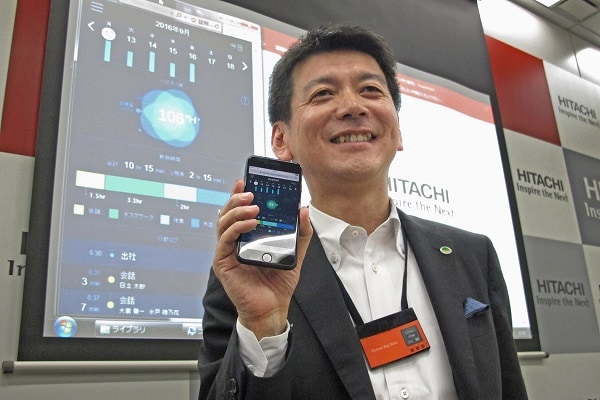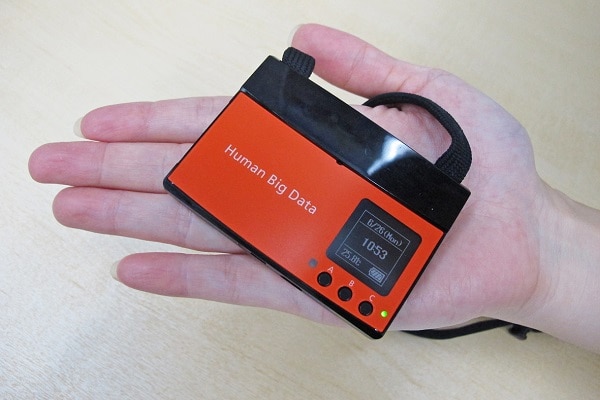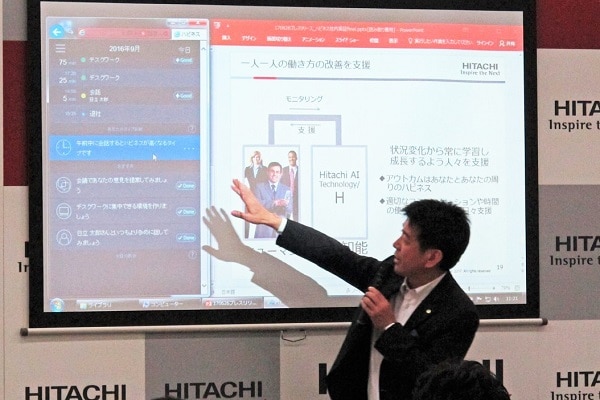
Kazuo Yano, Corporate Chief Scientist of the Research & Development Group, explains the work style advice provided by a smartphone app.
In March 2017, the Japanese government formulated the Work Style Reform Action Plan. In response, labor and management policies are driving a rising trend to revise and change work styles. The goal is to improve work style quality through enhancements to work hours, productivity, and other characteristics of work life. With its decades of experience in research into human behavior and quality, Hitachi had already begun in 2015 a service that employs analysis using Hitachi's AI system, known as Hitachi AI Technology/H. Now, Hitachi has taken the next step by conducting a demonstration experiment that, by testing AI-based advice on work styles, showed a link between enhancing the happiness of an organization and improving business performance. The key to this outcome was an application program linking individual people with AI.

This is a name tag type wearable sensor for measuring the actions and behavior of people within an organization. It is capable of collecting a wealth of action data, including who speaks to who for how long (via the meetups of people wearing the sensors) and, using a built-in accelerometer, how its wearer moves about. This system also uses stationary infrared room beacons that detect movement, which can then be used as data on group and organizational communication.
"I take pride in the fact that probably no other company has focused on human behavior and conducted this kind of research as early as Hitachi has," says Kazuo Yano, Corporate Chief Scientist of R&D group in charge of AI. He himself keeps a wearable terminal on for his own ongoing accumulation and analysis of data.
Hitachi has also been engaged in data collection since 2006, placing particular attention on productivity and human behavior. The name tag type wearable sensor used in this demonstration experiment has a built-in accelerometer that makes it possible to collect data on the actions of people in terms of level of movement. Yano wondered about a possible correlation between the movements of such individuals and the activation level of an organization. As he explains, "We set happiness level as an index for this. Using this metric, we succeeded in quantifying the organizational happiness level, by analyzing data from psychological state questionnaires and from the sensors."
The accelerometer detects even subtle movements that the wearer is not aware of. In fact, people repeatedly and unconsciously start and stop moving. This occurs both while going from place to place and during desk work. An analysis of bodily movements made during the entire time spent at the workplace, including during conversations with co-workers, computer work, and breaks, showed that diversity of sustained activation time for people throughout an organization indicated a higher organizational happiness level. Also concluded was that such an organization reaped higher productivity levels as well. In 2015, Hitachi launched a service using AI analysis that, based on behavioral data and the happiness level metric, devises advice on such factors as communication within the organization and use of time. Since then, over 20 organizations have introduced this system. As Yano explains,
"The demonstration experiment that we carried out tested a new service that provides AI analytical results as advice for individuals. The objective was to demonstrate the effectiveness of a system that enables each person to change their own work style with assistance from AI."
While the AI analysis of behavioral data gathered from wearable sensors and stationary infrared room beacons remains the same, the new system adds to this the direct delivery of AI analysis results to individual employees. This is accomplished by an application program developed by Hitachi. This application lets employees access individualized advice from AI through such common devices as smartphones and PCs. The advice is unique in that it not only informs employees on current situations and states of progress, it also displays advice on how to raise happiness level. According to Yano:
"Examples of such advice might be 'In your case, you should devote mornings to discussions with people rather than to desk work,' or 'Past data suggests that your happiness level will be enhanced by speaking up at meetings.' By 'enhancement of happiness level,' I mean the happiness levels of you and those around you, that is, the organization. This is advice for advancing the happiness of the organization."
The demonstration experiment testing individualized AI advice via the new application was carried out on 600 people in 26 internal departments. The results revealed that departments making greater use of the app that is, of advice from AI exhibited an increase in organizational activation level. These departments also beat next-quarter order volume targets by 11%. Says Yano:
"Being able to objectively quantify happiness is one thing, but raising happiness is another because it varies from person to person. This is a very human issue and is the very reason for the link up with AI. Although the use of AI will extend to many fields, AI needs to start with the question 'What do you want to improve?' Over many decades of focus on people, Hitachi has finally succeeded in arriving at the question of 'What is it that will enable the increasing of people's happiness?' AI gave us the answer to that question."

Kazuo Yano discusses the use of AI advice from the application.
Previously, the association between levels of happiness and performance was demonstrated at workplaces featuring a direct connection between a day's work and sales, such as at call centers. This demonstration experiment also included other types of workplaces where it is difficult to estimate how daily work will affect performance figures, such as sales departments. The results made clear that, using the rise and decline of the organizational activation level metric as leading indexes for performance estimates, even the said workplaces could make beneficial use of individual AI advice as delivered through the application. In the future, the use of this system is expected to expand into research and other areas characterized by a time gap between work and results.
Corporate Chief Scientist, Kazuo Yano says that AI technology is something that provides insights that a person might otherwise not notice. "Advice from AI lets you obtain insight into how you and those around you can become happy. It's a simple and important idea. After all, don't we all want to work where the mood is good?"
Release Date:September 2017
Solutions By:Hitachi, Ltd. Research & Development Group







